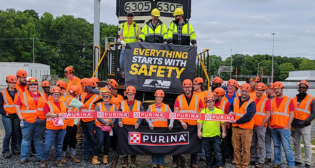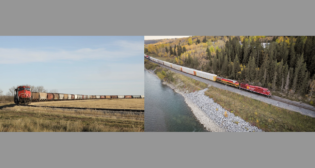
Cowen: 2Q22 Shipper Surveys Say …
Written by Matt Elkott, Jason Seidl, Bhairav Manawat and Elliot Alper, TD Cowen
According to the Cowen and Company Rail Equipment Survey for 2Q22, it appears that hoppers and gondolas saw demand improvement relative to 1Q22. Containers and centerbeams declined relative to 1Q22.
According to Cowen and Company’s recently conducted second-quarter 2022 Rail Equipment and Rail Shipper Surveys, the outlook for railcar orders is positive, and rail shipping rates will continue to increase. Details follow, plus insights on the Class I railroads, ahead of earnings.
The order outlook by the shipper sub-group of railcar buyers increased in the second quarter. This is likely driven by signs of steel prices easing and continued tightening in the industry fleet, partly offset by interest rate hikes and economic uncertainty. We still expect a strong production up-cycle, although the cadence is a function of macro variables.
Expected rail price increases were 4.6% in the second quarter, down 40 bps sequentially, but above our survey’s five-year average. Business growth and economic outlook stepped down again this quarter, with nearly 90% of shippers expecting a recession. Some 58% of shippers responded that rail service is impacting their transportation decisions.
What the Rail Equipment Survey Results Tell Us

Shippers’ order expectations are higher than they were in our first-quarter 2022 survey. It appears we are finally at a point where the railcar industry fleet is tight enough, and pockets of shortages are consequential enough to drive higher manufacturing orders, despite a murky macro outlook, at least by shippers facing decreased availability of certain cars at the lessors. Steel, which is a key culprit behind the industry fleet tightening of the last two years, is showing signs of easing. This could reduce the cost of buying a newly manufactured railcar. On the flip side, interest rates are higher, something that could cancel out the benefit of moderating steel. While we expect spot lease rates to continue their seven-quarter run of sequential quarterly improvements well into 2023, if steel prices ease materially, and the easing appears sustainable, manufacturing orders could see notable increases, which could eventually cause the lease rate momentum to moderate sometime next year. All else equal, the survey results are an incremental positive for The Greenbrier Companies (GBX), FreightCar America (RAIL), and privately held manufacturer National Steel Car, and to a lesser extent Trinity Industries (TRN).
Survey Summary
When it comes to order activity, we consider four key metrics: (1) the percentage of “all participating shippers” who will or may order railcars; (2) the conviction level about ordering (the split between “yes” and “maybe”) within this “all participating shippers” group; (3) the percentage of “same shippers” who will or may order railcars; and (4) the conviction level about ordering (the split between “yes” and “maybe”) within this “same shippers” group. In our second-quarter 2022 survey, the first three metrics improved, while the fourth deteriorated.
Roughly 52% of all shippers surveyed said they will or may order railcars in the next 12 months, above the 47% in first-quarter 2022. About 49% now say they do not plan to order railcars, compared with 53% in our first-quarter survey. Within the 52% of total shippers who are contemplating orders in the next 12 months, 67% said “yes,” they plan to place orders, vs. 65% in the first quarter; and 33% said “maybe,” compared with 35% in 1Q22.
On a same-shipper basis, about 51% of same shippers in second-quarter 2022 said they will or may order railcars, compared with 40% in our first-quarter 2022 survey.
What the Rail Shipper Survey Results Tell Us

Shippers anticipate rail prices to increase by 4.6% over the next six-to-12 months, down 40 bps compared with last quarter’s survey. The 4.6% result is above the survey’s five-year average of 3.6% and above the survey’s long-term 10-year average of 3.7%. We view the sequential step down in pricing as a near-term negative for the group, particularly after the rails have all cited an elevated cost environment. Union Pacific (UNP) revised its guidance downward at a recent industry conference, citing higher inflationary and network costs. Year-to-date, North American carloads are down 2.5%. The railroads have suffered from poor service metrics that have hindered volumes in 2022. While the railroads have been hiring, 69% of shippers stated they are having trouble hiring employees (though a 2% sequential improvement).
Business growth expectations declined 70 bps sequentially to 2.1%, and below the survey’s six-year average of 2.6%. The percentage of shippers expecting their employee counts to increase over the next 12 months fell 13% from last quarter’s response. Only 8% of shippers answered that they are more confident in the direction of the economy today than they were three months ago—the lowest on record for the survey, and notably below the survey’s 46% average. This is now the fourth quarter in a row that economic confidence has declined sequentially. A staggering 87% of shippers believe we are heading into a recession.
For the first time, we asked shippers if rail service has impacted their transportation decisions; 58% answered “yes”; it has impacted their decisions. As we previously highlighted from our State of the Ports call, poor rail service has been a bottleneck within the North American supply chain over the past several months. While the rails have leaned into hiring to improve service, it can take between four and six months before rail employees ramp up. Some 34% of shippers shifted from highway to rail in the last quarter, increasing 5% sequentially.
We also asked shippers if fuel costs are changing modal choices; 61% of shippers stated that fuel costs are changing modal choices, in line with our expectations, given that the price of U.S on-highway diesel is up approximately 60% year-to-date. Taken as a whole, we view both new questions we asked shippers as a net-neutral, given rail service has been a negative catalyst for the Class I railroads, while the cost of fuel has been a positive catalyst. While North American carloads are still approximately 6% below pre-COVID levels, we believe if the rails can clean up service metrics, there may be upside to volumes, given our assumption of the high cost of fuel for the intermediate term.

Insight on Rail Stocks Ahead of Earnings
Rail congestion continues to hinder volumes while pricing is expected to be approximately on par with first-quarter levels. Diesel prices lower our operating ratio assumptions in the near term, along with an elevated cost environment (hiring ramping); we see tailwinds associated with modal shifts, driven by energy pricing, while we are cautious on near-term network challenges. Given a continued decline in economic outlook and confidence, coupled with a step down in pricing growth, we view our survey as a near-term negative for the rail group. That said, we continue to favor Canadian Pacific as our top pick for rail exposure (for the longer-term benefits we see from the pending Kansas City Southern merger transaction) and Norfolk Southern (for a recovery in the company’s ability to handle more intermodal freight out east).



